Mumbai: On 30 June 2003, Standard & Poor's (S&P) ratings services affirmed its BB/B foreign currency and BB+/B local currency sovereign ratings on India. The rating agency also maintained the outlook as negative, which it attributed to the continuing difficulty for the government in addressing its fiscal problems and structural reforms.
This time S&P affirmation of continued junk grade status for India's foreign currency sovereign rating did not raise any heat and dust, as had been raised by the last one and the one before that when the outlook was changed to negative. But the usual arguments about rating agencies and their motivated actions as also the defensive ones about how the economy is not really as bad as it has been rated to be continue.
If we see the latest S&P maintenance of status quo in relation to what happened last time, it looks more like a correction on the last rating status, when it seems to have erred in its assessment, although going by the macroeconomic numbers alone. 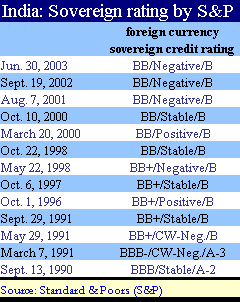
When S&P maintained status quo on 19 September 2002, it had overlooked distinct improvement in the Indian economy. The first half of the last fiscal was showing encouraging signs of a turnaround with critical sectors such as automobiles, steel and cement showing a positive growth. In fact, industrial growth in the first half was at 4.7 per cent, almost double that of the same period the year before. Exports also had registered a sharp 15.2 per cent rise compared to a negative growth the year before. Inflation at that time was also well under control. Most economic variables were showing positive trends though the gross domestic product (GDP) growth was projected to be lower than the initial estimate of 6 per cent. This was mainly due to an indifferent monsoon at that time, which left the first sowing season high and dry. And for all these positive features, there is one big negative factor that influenced S&P's rating assessment at that time - the stalling reforms programme of the government. Present foreign currency scenario
This time around India's forex reserves are strong and inflows continue to be robust. India has recently pre-paid around $3 billion of its external debt and India's ability to meet its foreign currency financial commitments are the best ever in recent history. Taking these facts into account, India needed an upgrade in its sovereign foreign currency ratings. Disturbing facts
Takahira Ogawa, credit analyst at S&P, in his sovereign rating report on India, says: "Rising public debt, projected at about 95 per cent of the GDP this year, and growing fiscal inflexibility from running general government deficits of about 10 per cent of the GDP over the past few years, are the most pressing issues affecting the sovereign's creditworthiness." 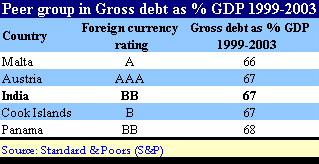
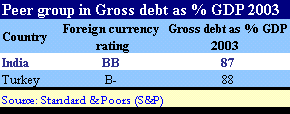
The report highlights the compounding of problems by the inability of India's political class, cutting across all parties, to reignite reform (particularly of the public sector) and to curb the borrowings of both state and central governments, which equal almost the entire financial savings of the country. Moreover, a growing share of public spending is diverted to meet interest payments and salaries for a bloated civil service. As a result, public investment declined to only 6 per cent of the GDP from 10 per cent over the past decade. But despite a decline in public investments overall investments as a per cent of the GDP and growth in investments are comparable to the best in the world. 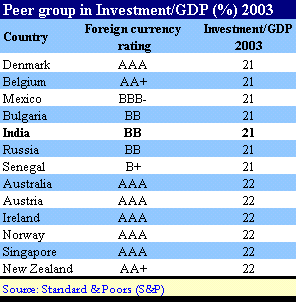
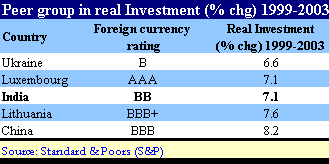
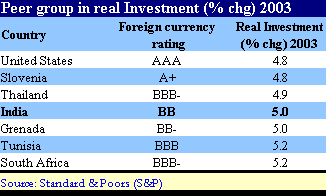
Hopes and positives
In its report, S&P has highlighted India's plus side as well. It ranges from India's comfortable external liquidity, sustained by growing foreign exchange reserves (exceeding 900 per cent of the short-term debt) to modest debt service payments. In addition the report agrees to the fact that driven by a booming private sector, the Indian economy has stable and good economic prospects and is likely to achieve a 5-6 per cent trend GDP growth in the medium term, which could help cushion its high fiscal deficit and contain the heavy government debt burden. This, in turn, means that the possibility of debt and fiscal deficit ratios to remain stable in the medium term is on the higher side. The risks
The S&P analyst seems overcautious in marking risks. He says: "The negative outlook reflects the risk that the government's debt burden may continue to rise rapidly over the medium term, especially if the GDP growth were to decelerate." Here he contradicts his earlier statement that the Indian economy has stable with good economic prospects and is likely to achieve a 5-6 per cent trend GDP growth in the medium term. It is a well-known fact that except for the monsoon (it is already doing well), the possibility of the Indian economy growing at 5.5-6 per cent is on the higher side. Superficial understanding
S&P's views on political leadership show a superficial understanding of the Indian political system. The report talks about a stronger political leadership on economic matters that could restore policy momentum and confidence, putting the GDP growth on a higher and more sustainable path. India has entered an era of coalition politics, which is expected to continue as current circumstances show. Polarisation of politics on the basis of caste, religion and region, which were the result of mandal and mandir, has brought to the fore the politics of coalition. This implies that consensus building would be an essential prerequisite for economic and policy decisions. This has been successfully practised in the disinvestment of public sector enterprises. Therefore, in the present political scenario wherein policies are being formulated and implemented, a strong political leadership on economic matters is neither possible nor is a necessary prerequisite. Speed up reforms and get rewarded
The report also talks about aggressive tax reforms and the implementation of proposed legislation to control fiscal deficits, which could control the growth of public debt. It states that measures like full implementation of value-added tax and better cost-recovery in public services, especially energy, could result in the outlook being revised back to stable. Energy reforms have begun but due to the impending general elections next year other reforms are bound to get delayed and, as clearly stated by S&P, the outlook will continue to be negative till then. India's peer group
India continues to be placed along with countries like Bulgaria, Colombia, Costa Rica, Guatemala, Kazakhstan, Morocco, Panama and Russia as far as foreign currency sovereign rating is concerned. Any person who tracks global economies will definitely disagree with this categorisation of India. The inherent strength of the Indian economy is far superior to the peer group in which it has been placed. 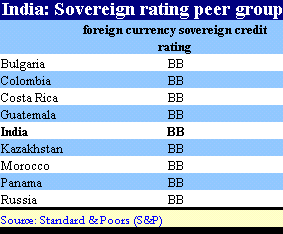
The affirmation of junk grade by S&P is unjustified, but it would still serve its purpose if it propels reforms back to where they belong- at the top of the government agenda.
also see : What
ratings mean
|